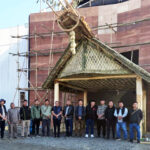Imagine a road that connects the entire state of Nagaland, paving the way for unprecedented growth and development. This is precisely what the Foothills Road, also known as the Trans-Nagaland Expressway, promises to deliver. Stretching about 400 kilometers along the fertile foothills of the Naga Hills, from Tizit in Mon to Khelma in Peren, the Foothills Road is not just a road; it is a lifeline that holds the key to Nagaland’s progress.
Born out of a vision that dates back to the 1960s, the Foothills Road project faced numerous obstacles over the years. Construction began in the 1990s, only to be halted by funding challenges and border disputes. However, thanks to the relentless efforts of the Nagaland Foothill Road Co-ordination Committee (NFHRCC), a remarkable turnaround occurred.
The NFHRCC, a non-profit organization comprising representatives from various Naga tribal hohos and civil society organizations in Nagaland, has been instrumental in reviving and championing the Foothills Road project. Against all odds, they have secured funds, persevered, and dedicated over a decade of unwavering effort. Their commitment deserves our utmost appreciation.
The completion of the Foothills Road would bring about a multitude of benefits for Nagaland. Enhanced connectivity between different parts of the state will be a catalyst for economic development and a thriving tourism industry. Moreover, essential services like healthcare and education will become more accessible to the people. Gone will be the days of depending on Assam for transportation, as the Foothills Road will provide a direct air and rail link to the rest of India. This newfound independence will revolutionize trade and commerce, making Dimapur the true commercial hub of the state.
Some may argue that the Foothills Road is even more crucial to Nagaland than the Kohima-Dimapur highway. It is disheartening to see successive governments fall short of realizing the dream of a “people’s road,” despite recognizing its significance. Nagaland’s state government alone cannot bear the financial burden of such a monumental project. The lack of interest from the central government, possibly due to the absence of perceived “national security” implications, only adds to the challenges.
While we await the grand vision of a “Trans Nagaland Expressway” as envisioned by the Nagaland Legislative Assembly, let us not lose sight of the immediate need to make the Foothills Road motorable. The NFHRCC’s vision must be actualized without delay.
The Foothills Road is not just an ordinary road; it is a transformative force that will shape Nagaland’s future. We must unite in recognizing its paramount importance and urge both state and central governments to prioritize its construction in order to forge a brighter path for Nagaland, one that embraces progress, connectivity, and prosperity. The time to build the Foothills Road is now.



